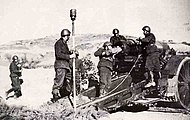|
15 cm Autokanone M. 15/16
The 15 cm Autokanone M. 15/16 was a heavy field gun used by Austria-Hungary in World War I. Guns turned over to Italy as reparations after World War I were taken into Italian service as the Cannone da 152/37. Austrian and Czech guns were taken into Wehrmacht service after the Anschluss and the occupation of Czechoslovakia as the 15.2 cm K 15/16(t). Italian guns captured after the surrender of Italy in 1943 were known by the Wehrmacht as the 15.2 cm K 410(i). Due to their unique ammunition, the Germans did not use them that much, and generally served on coast-defense duties during World War II. DesignThe M. 15 was a thoroughly conventional design for its day with a box trail, iron wheels and a curved gunshield. It was notable as being the first Austro-Hungarian gun to be designed for motor transport, towed behind the M 17 'Goliath' artillery tractor, hence the Autokanone designation. For transport the barrel was generally detached from the recoil system and moved on its own trailer. The original M. 15 weapons had a maximum elevation of only 30°, but an elevation of 45° was demanded early in the gun's production run, mainly to engage high-altitude targets in the mountains. 27 M. 15 guns were completed before production switched to the improved M. 15/16 with greater elevation in the first half of 1917. A total of 44 barrels and 43 carriages were completed by the end of the war.[1][2] It seems likely that surviving M. 15 guns were rebuilt after the war to M. 15/16 standards. During the Twenties, guns in Italian service were relined and given new wheels by Vickers-Terni. In June 1940 Italy had 29 Cannone da 152/37 in service. By the time of the Italian capitulation this number had declined to 17.[3] Photo GalleryReferences
Bibliography
External linksThe Autokanone M 15/16 on Landships at the Wayback Machine (archived February 22, 2012) |
||||||||||||||||||||||||||||||||||||||||||||||||||||||||||



